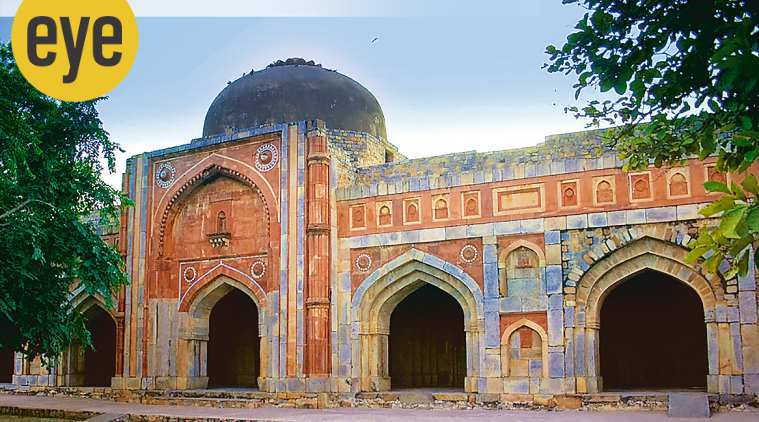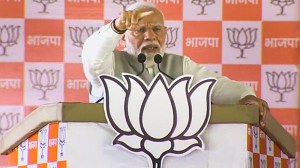- India
- International
Narayani Gupta: ‘Time and again, Delhi has opened its gates to the helpless and hopeful’
The historian, 77, on growing with the nation’s capital.
 Time goes by: The Jamali Kamali Mosque in Mehrauli, Delhi (Source: Wikimedia)
Time goes by: The Jamali Kamali Mosque in Mehrauli, Delhi (Source: Wikimedia)
Age does not increase wisdom, it merely adds layers of recollections. The brain sifts out what it wants to retain and saves them as memories. These are often complicated by knowledge from hindsight.
1951: Silent City
Scrambling through the bramble, we came up short against a mosque; its courtyard had a corner enclosure. We were wonderstruck. The interior was a luminous carpet, covered entirely with stucco work in rich colours. (Delhi’s Jamali Kamali Mosque is now part of the Mehrauli Archaeological Park; the tomb-chamber, brutally vandalised, is kept locked).
We had to get away by dusk; the villagers cautioned us against dakus (dacoits). On the long road home, the high walls enclosing Chiragh Dilli shimmered with the light of diyas and the air was spiced with the smell of slow-cooking sarson ka saag. The swiftness of the car’s movement meant that we did not read the silence — Mehrauli, Begumpur, Chiragh Dilli had lost so many of their inhabitants, and the forlorn groups gathered around fires were lost people who dreamed incessantly of homes in West Punjab, in the Frontier Province. It was only decades later that the villagers of Begumpur told us how in 1947 their masjid had served as a qila, sheltering them, its courtyard divided between Muslims and Hindus; and how in Chiragh Dilli the Hindu families had sheltered the Muslim villagers.
Twenty-five years later, my family was to make its own home in a few square yards of the grazing lands of Chiragh Dilli village, gentrified into yet another Greater Kailash.
1961: Safe City
Dusk deepened into night as we sat on the verandah of Indraprastha College getting things ready for a fete. The building, the commander-in-chief’s house, had been gifted to the college in 1932 but had not made the students grateful and loyal subjects. They had joined whole-heartedly in the Quit India Movement. Somehow that spirit continued to characterise future generations.

Home was Mandi House, a comfortable bus-ride away, safe at 11 pm. Originally a Raja’s town-house, its lawns had been covered with “hutments” for immigrants. Two decades later, the house was reduced to malba, the roof where the doves cooed on hot summer afternoons (and where I had frantically paced up and down preparing for exams) was thin air. In its place, teetered the Doordarshan Kendra, a façade looking like TV screens.
1971: Multilingual City
Home was now Tagore Park. The shortest way to get there was to walk from Kingsway Camp (the pomp and glory of 1911!), which in 1947 had been a camp for the rehabilitation of families from across the border. The neighbourhood was in the making, with pitted roads and power cuts. Bengali families were busily building new homes. Their hearts were still in Bikrampur (Munshiganj in Bangladesh) or Chattogram (Chittagong). There was surprise, then exhilaration, as they heard that the same Bikrampur and Chattogram were plunging into a second war of independence.
1984: Menacing City
Delhi is a restless seafront, where many people are thrown ashore because of violence in a distant land or cruel hunger nearer home. Slowly, they filled the vast empty interstices, only to be swept out to “resettlement colonies” with names suffixed with “puri”. It was a subtle put-down; in November 1984 we could not find them marked on any map.
Dusk came to be associated with utter sadness and disbelief — travelling home on the evening of October 31, 1984, through a horror-film landscape of smouldering buses and two-wheelers. Days later, on a bus in the late evening, one suddenly realised one was the only woman on board, and some of the passengers may well have blood on their hands.
1991: Inclusive City
It was deeply satisfying to teach in Jamia Millia Islamia, where, as in Indraprastha College, the exhilaration of the nationalist movement never disappeared. The university tarana (“This is the land of my hopes/This is the land of my dreams”) and the students’ eagerness to understand the power of nationalism connected them with the founders of 1921, who included the Ali brothers and Gandhiji.
December 2019: Tragic City
Dusk is the time at home when the TV is briefly switched on, only to see one’s city burn again — with the hate of the few, with the clumsy and devastating firearms of the many.
2020: Large-hearted City
Time and again, Delhi has opened its gates to the helpless, the hopeful. Time and again, after sudden violence, it has rejuvenated itself. The winter of 1984 and the spring months of 2020 saw a frightening callousness — or maybe it seemed excessive to me because I experienced it. There were also sparks of hope.
The Krishna who ends the shloka with tada atmanam srjami aham was young at heart, full of quiet energy. He does not have to come as an individual “leader”. He can be many. The spirit of Krishna is in the young people of Delhi, and the country — energetic and empathetic, using their technical and organisational skills to help the community. They have helped street artistes find livelihoods, helped children understand their city and translate it into theatre, created vibrant “art districts”, restored our timeless architecture and fed the hungry, imbibing the large-heartedness of Delhi’s grand gurdwaras, symbols of India’s youngest religion, where faith is a way of community life.
Buzzing Now
Apr 20: Latest News
- 01
- 02
- 03
- 04
- 05







































